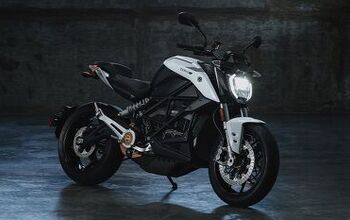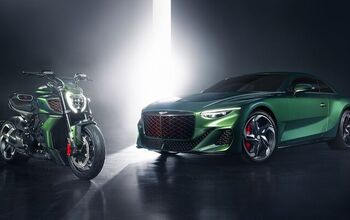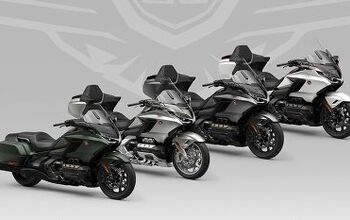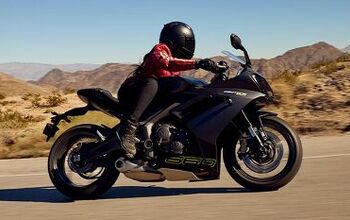Manifesto for Reclassifying Motorcycles as Transportation in the United States.
My friends, traffic congestion is a serious problem in the United States, and we are literally sitting on the solution.
According to the US Federal Highway Administration, in 2000 the 75 largest metropolitan areas "experienced 3.6 billion vehicle-hours of delay, resulting in 21.6 billion liters (5.7 billion gallons) in wasted fuel and
Whose fault is it, anyway? When I'm stuck in traffic in a car, I become irrational and blame "the idiots." The Idiots are basically anybody who isn't me, from Soccer Mom in the mammoth SUV to Urban Gangster Guy weaving through traffic in his Five-O with the seat leaned back so far he can't see over the wheel. In my pent-up rodent mind, if only everyone would drive like me, there would be no traffic jams.
In reality, about half of all traffic congestion nationwide is caused by either accidents, disabled vehicles or "incidents": weather, road construction, or even something interesting by the side of the road. The other half (more or less) is caused by what the DOT labels "recurring events": the fact that there are just not enough roads for all the vehicles that want to use them.
Since 1980, we've added about 1.5% more capacity to our nation's highways, but our usage of motor vehicles increased 76% in that same time. What that means to those of us forced to drive on congested freeways is that if you want to get somewhere during "peak hours" (basically when the sun is up), you have to get in line and wait your turn to use the freeway. Pretty sad for a culture that values personal freedom above almost anything else.
And here's some news for you: nobody has any workable solutions. Of the thousands and thousands of studies and documents that explore solutions to this problem, only three basic options are given any serious consideration.
The next solution is increasing roadway capacity, and this would appear on the surface to be a no-brainer. The problem is that of what urban affairs authority Anthony Downs calls the "Principle of Triple Convergence". This simply means that as soon as you increase road capacity, usage also increases as road users learn of the improved flow which brings congestion back to previous levels. You can see evidence of this anytime you look at traffic around a major freeway expansion project in a growing metropolitan area. Developers and commuters take advantage of the increased capacity until there are way more cars then before, and you once again have an overloaded roadway. Increasing road capacity does have benefits and is in fact necessary, but it will never solve our transportation problems fully. There isn't enough concrete and space in the world!
The third solution is the favorite of environmentalists, the political left, Euro-philes and model railroaders alike: mass transit! The people that love mass transit, oddly, never seem to be on the bus next to the vomiting wino, but they do push for billions of dollars in mass-transit funding. The problem with mass transit is that it only really makes sense in very high-density regions, regions where most Americans only live if they have to. Why would you shell out big tax dollars, plus pretty pricey fares (BART in the San Francisco Bay Area costs between six and 14 dollars per round trip) to endure the inconvenience of mass transit when you only save a few minutes and a few dollars after you figure the time and expense of the intermediate trips? (Intermediate Trips are the trips from your location to the mass transit station, and then from the station to your final destination, which may be by foot, bicycle, taxicab, city bus, etc.)
Mass transit works great for Euro-greenie-weenies in densely populated Europe with its six buck per gallon gasoline, but most Americans will die of starvation in a traffic jam before they get on a bus or train to get to work.
"The principal aim of our strategy is to 'mainstream' motorcycling..."
There is a fourth "solution" that most government officials and policy wonks in the USA espouse as well: live with it, losers! In fact, this is the one we implement every day. Anthony Downs provides these helpful words of wisdom for us poor slobs:
"Get a comfortable air-conditioned vehicle with a stereo system, a tape deck and CD player, a hands-free telephone, perhaps even a microwave oven, and commute daily with someone you really like. Learn to make congestion part of your everyday leisure time, because it is going to be your commuting companion for a long time."
Heck, why not just buy a freakin' RV and be done with it? You can put it in neutral, go to the back and let the flow of traffic move you along while you watch TV. We pay for this solution everyday, with more and more money being spent on ever larger, more luxurious vehicles with James Bondian arrays of features and more cup holders than Dodger Stadium. The problem with this is that it's like a battered spouse buying a helmet to deal with an abusive husband: it's not actually a solution, just a survival strategy.
If you're happy with that, then read no further. But if you want to see motorcycles integrated into the transportation system of our country, let's look at what they're doing in England.
David Jamieson, Minister for Transport, writes: "The principal aim of our strategy is to 'mainstream' motorcycling, so that all the organisations involved in the development and implementation of transport policy recognise motorcycling as a legitimate and increasingly popular mode of transport." Holy smoke! Would a statement like that cause mayhem and looting in the streets of our country? Can you imagine a DOT official saying that? But in the view of the UK government, PTW's are just that: powered two wheelers, with no more social stigma or message than a catering truck or Subaru Outback.
I was listening to an episode of Talk of the Nation on NPR about traffic congestion and transportation policy and sent in an email (they read it at 39:50 minutes into the program) asking why motorcycles and scooters weren't considered in transportation policy. Mark Hallenbeck, Director of the Washington State Transporation Center at the University of Washington responded that scooters and motorcycles were considered as bicycles and that he "wasn't sure" he'd want them "taking up space" in HOV (commuter) lanes! This kind of short-sighted prejudice is simply ignorance, unexpected from a scholarly person like that.
As transportation, PTW's make incredible sense. They are economical to purchase, operate, maintain and insure, have a light impact on infrastructure, require a small space to park and can "filter" through traffic so that their impact on traffic volume is usually less than minimal. As motorcyclists these things are obvious to us, but to policy decision-makers and advisors they must be pointed out, and not just by biker-friendly advocacy groups like the AMA and ABATE.
To be fair, the AMA does emphasize using motorcycles as transportation as an "underlying theme of everything we do", according to Tom Lindsay, director of Public Information for the American Motorcyclist Association. However, he did not point me to a single program of the AMA that focuses on integrating PTWs into the Nation's transportation policy. Instead, the AMA and other like organizations focus on an agenda important to their membership: helmet laws, medical insurance issues, and keeping wilderness open to ride.
These groups are just reflecting the culture of American motorcyclists, who have focused culturally on motorcycling as a leisure activity, not as a means of transportation. Years of portraying motorcyclists as wild-eyed thugs and rapists on TV and in movies haven't helped much, either. American motorcyclists make a huge part of the population- over a million motorcycles were sold in 2004- but a tiny, tiny percentage of commuters. I saw maybe 20 other motorcyclists in a 60 mile trip from San Clemente to Torrance during the morning commute hour, and less than 800 motorcycles use the Bay Bridge from Oakland to San Francisco during the morning commute hours, out of some 70,000 cars. But organizers for Daytona and Sturgis routinely see hundreds of thousands of motorcyclists show up at their annual events. Motorcycles are for draping naked ladies over, not going to work on.
Such integration could include tax breaks to motorcyclists, like Zero Emissions vehicles get in California. It could be a public information campaign like the present "ESUVEE" campaign extolling the virtues of motorcycling, or a billboard campaign in the highest-congestion areas.
Even a moderate increase in the number of present day motorcyclists getting on their bikes and riding to work could have a significant impact on congestion. A study in the UK found that a 10% increase in PTW traffic correlated to a 20% decrease in traffic congestion. If that sounds amazing, keep in mind that busy freeways- and most of the freeways in this country that are commonly congested are operating at 25-40% in excess of their design capacity when they are flowing freely- only need a small disturbance like a parked tow truck on the shoulder to become congested.
I would assume this means that we have the power to change things right now, today, by just picking a motorcycle from our stable and riding it to work. I understand if you're a plumber or mortician and you need a big vehicle to schlep your stuff around. But most of us are office geeks. We can store our boots and suits under our desks or in a locker, plus we can enjoy the benefits of easier parking and getting up a little bit later than our four-wheeled colleagues.
Aerostich's Andy Goldfine has a great organization that advocates motorcycle transportation. He sponsors National Ride to Work Day every July. [Wednesday, July 20th, 2005] But why wait for July?
It's a perfect day for riding today.
More by Gabe Ets-Hokin































Comments
Join the conversation